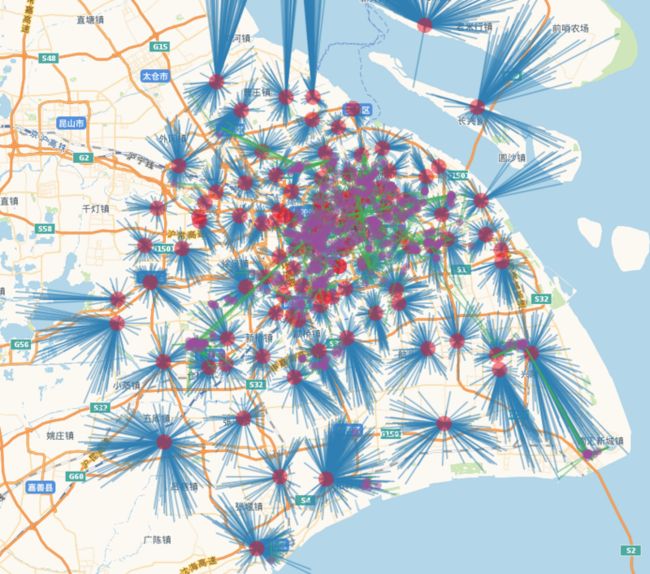前言
最近公司组织了一场大咖秀,有位讲师建议我们没事多参加阿里的天池大赛,说是对提高自己很有帮助。于是想起自己几天前看到的FinanceR专栏的天池最后一公里,便紧随偶像步伐,注册并下载了一份数据,凑个热闹。详情请点击赛题介绍
此文为截图版,需要js交互版的原文请点击这里
简单分析
数据有三种类型的节点。第一类是Site,电商订单发货节点。第二类是Shop,O2O订单发货节点。第三类是Spot,消费者收获节点。电商订单的要求比较松,只需在当天晚上8点前配送完毕即可。O2O订单比较着急,必须在指定的时刻前去Shop取货,并在指定的时刻去Spot送货。
首先,我们将电商订单的情况打到地图上看一下。
library(readr)
library(plyr)
library(dplyr)
library(tidyr)
library(ggplot2)
library(plotly)
library(lubridate)
library(leaflet)
library(sp)
library(RColorBrewer)
library(jsonlite)
library(splitstackshape)
library(stringr)
library(rlist)
# 辅助函数
points2spline <- function(df, x_field, y_field, id_field){
data <- as.matrix(df[,c(x_field, y_field)])
id = df[1, id_field]
Lines(list(Line(data)), ID=id)
}
# 探索Site与Spot的空间关系
df.site <- read_csv("1.csv")
df.spot <- read_csv("2.csv")
df.e.order <- read_csv("4.csv")
df.site.spot <- df.e.order %>%
inner_join(df.site, by=c("Site_id")) %>%
inner_join(df.spot, by=c("Spot_id")) %>%
unite(Point_x, ends_with("x")) %>%
unite(Point_y, ends_with("y")) %>%
gather(point, location, Point_x, Point_y) %>%
separate(location, c("Lng", "Lat"), sep="_", convert=TRUE) %>%
unite(Line_id, Site_id, Spot_id, remove=FALSE)
df.site <- df.site %>%
inner_join(df.site.spot %>%
group_by(Site_id) %>%
dplyr::summarise(order_cnt=sum(Num)),
by=c("Site_id"))
ls.site.spot <- split(df.site.spot, df.site.spot[, c("Line_id")])
names(ls.site.spot) <- NULL
sl.site.spot <- SpatialLines(llply(ls.site.spot, points2spline, "Lng", "Lat", "Line_id"))
m <- leaflet() %>%
addTiles(
'http://webrd02.is.autonavi.com/appmaptile?lang=zh_cn&size=1&scale=1&style=8&x={x}&y={y}&z={z}',
tileOptions(tileSize=256, minZoom=9, maxZoom=17)
) %>%
addPolylines(data=sl.site.spot, weight=2, color="#377EB8") %>%
addCircleMarkers(lng=~Lng, lat=~Lat, radius=~order_cnt/1000, data=df.site, stroke=FALSE, fill=TRUE, fillColor="#E41A1C", fillOpacity=0.5, popup=~paste0("Order Num: ", order_cnt)) %>%
fitBounds(sl.site.spot@bbox["x", "min"],sl.site.spot@bbox["y", "min"], sl.site.spot@bbox["x", "max"], sl.site.spot@bbox["y", "max"])
m图中红色的圆圈就是每个Site,半径越长表明出货量越大。蓝色的线表示这个Site与它负责的电商订单的Spot的连线。可以看出Site和Spot之间是一一对应的关系,不存在交叉,所以如果只考虑电商订单,这就是一个比较简单的VRP问题,可以分而治之,每个Site单独规划。
但是呢,我们还有一堆O2O订单要一起配送,这就让问题的复杂度骤然提升了难度。我们先来看一下O2O订单的空间分布。
df.shop <- read_csv("3.csv")
df.o2o.order <- read_csv("5.csv")
df.shop.spot <- df.o2o.order %>%
inner_join(df.shop, by=c("Shop_id")) %>%
inner_join(df.spot, by=c("Spot_id")) %>%
unite(Point_x, ends_with("x")) %>%
unite(Point_y, ends_with("y")) %>%
gather(point, location, Point_x, Point_y) %>%
separate(location, c("Lng", "Lat"), sep="_", convert=TRUE) %>%
unite(Line_id, Shop_id, Spot_id, remove=FALSE)
ls.shop.spot <- split(df.shop.spot, df.shop.spot[, c("Line_id")])
names(ls.shop.spot) <- NULL
sl.shop.spot <- SpatialLines(llply(ls.shop.spot, points2spline, "Lng", "Lat", "Line_id"))
df.shop <- df.shop %>%
inner_join(df.shop.spot %>%
group_by(Shop_id) %>%
dplyr::summarise(order_cnt=sum(Num)),
by=c("Shop_id"))
m <- leaflet() %>%
addTiles(
'http://webrd02.is.autonavi.com/appmaptile?lang=zh_cn&size=1&scale=1&style=8&x={x}&y={y}&z={z}',
tileOptions(tileSize=256, minZoom=9, maxZoom=17)
) %>%
addPolylines(data=sl.shop.spot, weight=2, color="#4DAF4A") %>%
addCircleMarkers(lng=~Lng, lat=~Lat, radius=~5, data=df.shop, stroke=FALSE, fill=TRUE, fillColor="#984EA3", fillOpacity=0.5, popup=~paste0("Order Num: ", order_cnt)) %>%
fitBounds(sl.shop.spot@bbox["x", "min"],sl.shop.spot@bbox["y", "min"], sl.shop.spot@bbox["x", "max"], sl.shop.spot@bbox["y", "max"])
m途中紫色的点为每个shop,绿线为O2O订单的spot与shop的连线。从空间上看,O2O的订单分布就比较散乱了。我们将O2O订单和电商订单的分布叠到一起看一下效果:
叠在一起后,我们能够很明显地看到O2O订单范围比电商范围小,集中在市区。
下面,我们模仿下FinanceR的思路,看一下O2O提单与配送时间的分布。
fake_dt <- "20160806"
o2o.hour <- df.o2o.order %>%
mutate(pickup_hour=round_date(ymd_hm(paste0(fake_dt, Pickup_time)), "hour"),
delivery_hour=round_date(ymd_hm(paste0(fake_dt, Delivery_time)), "hour")) %>%
gather(time_type, tm, pickup_hour, delivery_hour) %>%
group_by(time_type, tm) %>%
summarise(order_cnt=n())
ggplot(o2o.hour) + geom_point(aes(x=tm, y=order_cnt, colour=time_type)) + geom_line(aes(x=tm, y=order_cnt, colour=time_type)) + theme_bw(base_size=16)O2O订单有一个特点,就是比较碎。从数据中我们可以看到存在同一个spot在不同时刻向同一个shop下的订单。如果把这些碎订单拼凑在一起统一配送的话,能够节约很大成本。那么这种拼单思路的操作空间有多大呢?
df.o2o.order.batch <- df.o2o.order %>%
mutate(batch_pickup_time = round_minute(ymd_hm(paste0(fake_dt, Pickup_time)), 30),
batch_delivery_time = round_minute(ymd_hm(paste0(fake_dt, Delivery_time)), 30)) %>%
group_by(Spot_id, Shop_id, batch_pickup_time, batch_delivery_time) %>%
summarise(total_order_size=sum(Num), total_order_num=n())
table(df.o2o.order.batch$total_order_num)在拼单的时候,考虑到用户体验,将pickup和delivery时刻取整为最近的30分钟时刻,再分组统计并单数量。结论是2975单无法拼单,143个订单能2单合并,4个订单能3单合并。所以,仿佛拼单预处理的优化空间不是很大,关键还是在这个配送问题本身。
VRP入门
最后一公里急速配送这个比赛,是一道十分困难的VRP问题。学术上,这种问题称为VRPPDPTW,添加的后缀PDP表示Pickup Delivery Problem,即允许沿途取货送货;TW表示Time Window,即配送存在时间窗口约束。这么复杂的问题,我这种菜鸟肯定是搞不定的。
所以本文暂且把O2O订单抛开,来解一解单纯的电商订单问题。前文已经提到,电商的最后一公里配送网规划得比较整齐,一个site对一个spot,order之间没有交集,因此可以逐个site求解。本文采用的方法是Saving Method。
# 辅助函数
## 赛题规定的两点距离计算公式
p2pdist <- function(lng1, lat1, lng2, lat2){
diff_lat = (lat1 - lat2)/2
diff_lng = (lng1 - lng2)/2
coors_sum = (sin((pi * diff_lat )/180))^2 + cos((pi * lat1)/180) * cos((pi * lat2)/180)*(sin((pi * diff_lng )/180))^2
result = 2 * 6378137 * asin (sqrt(coors_sum))
return(result)
}
## 赛题规定的配送员默认速度是250m/min
distance_time_cost <- function(distance, speed=250) {
return(round(distance/speed))
}
## 赛题规定的订单处理时间
processing_time_cost <- function(package_num) {
return(round(3*sqrt(package_num) + 5))
}
# Saving Method
get_sub_data <- function(target.site, df.site, df.spot, df.e.order) {
target.site.geo <- df.site %>%
inner_join(df.e.order %>%
group_by(Site_id) %>%
dplyr::summarise(Num=sum(Num)),
by=c("Site_id")) %>%
filter(Site_id==target.site)
target.spot.geo <- df.e.order %>%
filter(Site_id==target.site) %>%
inner_join(df.spot, by=c("Spot_id")) %>%
arrange(Spot_id)
target.site.geo$Index <- 0
target.spot.geo$Index <- 1:nrow(target.spot.geo)
points <- rbind(target.site.geo %>%
select(Index, Site_id, Lng, Lat, Num) %>%
dplyr::rename(ID=Site_id),
target.spot.geo %>%
select(Index, Spot_id, Lng, Lat, Num) %>%
dplyr::rename(ID=Spot_id)
)
return(points)
}
get_cost_matrix <- function(points.matrix) {
cost.matrix <- matrix(0, nrow(points), nrow(points))
for(i in 1:nrow(cost.matrix)) {
for(j in i:nrow(cost.matrix)) {
cost.matrix[i, j] = p2pdist(points.matrix[i, 1],
points.matrix[i, 2],
points.matrix[j, 1],
points.matrix[j, 2])
}
}
return(cost.matrix)
}
get_saving_matrix <- function(cost.matrix) {
saving.matrix <- matrix(0, nrow(points)-1, nrow(points)-1)
for(i in 2:(nrow(cost.matrix)-1)) {
for(j in (i+1):nrow(cost.matrix)) {
saving.matrix[i-1, j-1] = cost.matrix[1, i] + cost.matrix[1, j] - cost.matrix[i, j]
}
}
return(saving.matrix)
}
get_vrp_init_solution <- function(demand.vec, cost.matrix) {
route <- list()
for(i in 1:nrow(demand.vec)) {
load = as.integer(demand.vec[i, "Num"])
processing_time = processing_time_cost(load)
distance = 2*cost.matrix[1, i+1]
distance_time = distance_time_cost(distance)
route <- list.append(route,
list(route_node=c(i),
load=load,
processing_time=processing_time,
distance=distance,
ddistance_time=distance_time
)
)
}
return(route)
}
get_vrp_saving_solution <- function(route, saving.matrix, capacity=140) {
saving.idx <- order(saving.matrix, decreasing = T)
for(k in 1:length(saving.idx)) {
cur_saving <- saving.matrix[saving.idx[k]]
if(cur_saving <= 0) {
break
}
i <- saving.idx[k] %% nrow(saving.matrix)
j <- saving.idx[k] %/% nrow(saving.matrix) + 1
p1.idx <- list.which(route, i %in% route_node)[1]
p2.idx <- list.which(route, j %in% route_node)[1]
p1 <- route[[p1.idx]]
p2 <- route[[p2.idx]]
# Condition 1: i and j not in the same route
if(p1.idx != p2.idx) {
total_load <- p1$load + p2$load
total_distance <- p1$distance + p2$distance - cur_saving
total_processing_time <- p1$processing_time + p2$processing_time
# Condition 2: combine load still less than capacity
if(total_load < capacity) {
idx1 <- which(p1$route_node == i)
idx2 <- which(p2$route_node == j)
# Condition 3: both i or j at the head or end of the route
if(idx1 == 1 & idx2 == 1) {
new_route_node <- c(rev(p1$route_node), p2$route_node)
}
else if(idx1 == length(p1$route_node) & idx2 == 1) {
new_route_node <- c(p1$route_node, p2$route_node)
}
else if(idx1 == 1 & idx2 == length(p2$route_node)) {
new_route_node <- c(p2$route_node, p1$route_node)
}
else if(idx1 == length(p1$route_node) & idx2 == length(p2$route_node)) {
new_route_node <- c(p2$route_node, rev(p1$route_node))
}
else {
next
}
route <- route %>%
list.remove(c(p1.idx, p2.idx)) %>%
list.append(list(route_node=new_route_node, load=total_load, processing_time=total_processing_time,
distance=total_distance, distance_time=distance_time_cost(total_distance)))
}
}
}
return(route)
}
## 绘制结果
plot_vrp_route <- function(route, points) {
df.route <- route %>%
list.map(list(spot_idx=str_c(route_node, collapse=","), load=load)) %>%
list.stack() %>%
mutate(id=1:length(route), Index=paste0("0,", spot_idx, ",0")) %>%
cSplit(c("Index"), direction="long") %>%
inner_join(points,
by="Index")
target.site.geo <- points %>% filter(Index == 0)
ls.route <- split(df.route, df.route$id)
names(ls.route) <- NULL
sl.route <- SpatialLines(llply(ls.route, points2spline, "Lng", "Lat", "id"))
ids <- data.frame(names(sl.route))
colnames(ids) <- "id"
sldf.route <- SpatialLinesDataFrame(sl.route, ids, match.ID = "id")
factpal <- colorFactor(brewer.pal(8, "Dark2"), domain=df.route$id)
m <- leaflet() %>%
addTiles(
'http://webrd02.is.autonavi.com/appmaptile?lang=zh_cn&size=1&scale=1&style=8&x={x}&y={y}&z={z}',
tileOptions(tileSize=256, minZoom=9, maxZoom=17),
group="高德地图"
) %>%
addCircleMarkers(data=target.site.geo, radius=15, stroke=FALSE,
fill=TRUE, fillColor="#E41A1C", fillOpacity=0.8,
group="Site") %>%
addCircleMarkers(lng=~Lng, lat=~Lat, radius=3, data=df.route, color=~factpal(id), group="Spot") %>%
addPolylines(data=sldf.route, weight=3, color=~factpal(id), group="配送路线") %>%
fitBounds(sldf.route@bbox["x", "min"], sldf.route@bbox["y", "min"], sldf.route@bbox["x", "max"], sldf.route@bbox["y", "max"]) %>%
addLayersControl(
baseGroups = c("配送路线"),
overlayGroups = c("Site", "Spot", "高德地图"),
options = layersControlOptions(collapsed = FALSE)
)
return(m)
}
## 普通VRP主函数
vrp_saving_method <- function(points) {
points.matrix <- as.matrix(points %>% select(Lng, Lat))
cost.matrix <- get_cost_matrix(points.matrix)
demand.vec <- points %>%
filter(Index != 0) %>%
select(ID, Num)
init_route <- get_vrp_init_solution(demand.vec, cost.matrix)
saving.matrix <- get_saving_matrix(cost.matrix)
saving_route <- get_vrp_saving_solution(init_route, saving.matrix)
return(saving_route)
}
## 取出一个例子
target.site <- "A083"
points <- get_sub_data(target.site, df.site, df.spot, df.e.order)
saving_route <- vrp_saving_method(points)
plot_vrp_route(saving_route, points)Saving Method规划的结果总体来看质量还是很不错的。简单说一下实现Saving Method的思路:构造cost矩阵和demand向量;构造初始解,即从site派专车送货到spot然后返回site;算saving matrix;将saving从大到小排序,逐个取出,判断这个saving对应的两个路线合并后车辆Capacity或时间窗等约束是否被满足,若满足则合并路径。其他常见的构造性的启发式算法还有Insert和Sweep;然后有一些听过大名的模拟退火、禁忌搜索等算法,不甚了解。由于学艺不精,时间有限,此题只能做到这里打住了。




